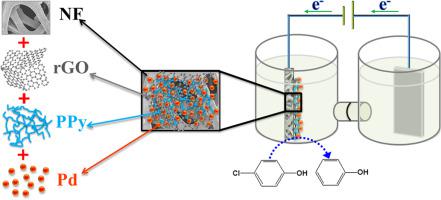当前位置:
X-MOL 学术
›
J. Electroanal. Chem.
›
论文详情
Our official English website, www.x-mol.net, welcomes your feedback! (Note: you will need to create a separate account there.)
Enhanced electrochemical dechlorination of 4-chlorophenol on a nickel foam electrode modified with palladium, polypyrrole and graphene
Journal of Electroanalytical Chemistry ( IF 4.5 ) Pub Date : 2020-07-01 , DOI: 10.1016/j.jelechem.2020.114099 Hongbin Yu , Shuang Yang , Bin Zhao , Ying Lu , Suiyi Zhu , Xinhong Wang , Weichao Qin , Mingxin Huo
Journal of Electroanalytical Chemistry ( IF 4.5 ) Pub Date : 2020-07-01 , DOI: 10.1016/j.jelechem.2020.114099 Hongbin Yu , Shuang Yang , Bin Zhao , Ying Lu , Suiyi Zhu , Xinhong Wang , Weichao Qin , Mingxin Huo

|
Abstract A composite electrode of Pd/polypyrrole-reduced graphene oxide/foam nickel (Pd/PPy-rGO/NF) with excellent dechlorination performance was prepared by pulse electrodeposition of Pd nanoparticles on the interlayer of PPy-rGO. The physicochemical properties of the electrode were systematically characterized by scanning electron microscopy, X-ray diffraction, X-ray photoelectron spectroscopy and cyclic voltammetry. 4-chlorophenol (4-CP) was selected as a model chlorinated organic pollutant to investigate the dechlorination property of electrodes and optimize the dechlorination conditions and electrode preparation conditions. The results indicated that the morphology of the Pd/PPy-rGO/NF electrode exhibited porous nano-grids, and the Pd content as low as 0.430 mg/cm2. By using this electrode, 95.8% of 4-CP could be dechlorinated in 120 min with a relatively high current efficiency of 39.9%. A new parameter named as specific current efficiency (SPCE), which can be calculated through dividing the current efficiency by the Pd content on unit electrode surface, was proposed to estimate the role of Pd in dechlorination. The SPCE obtained in this work was as high as 92.9%/(mg/cm2). Compared with the electrode without the interlayer of PPy-rGO, the Pd/PPy-rGO/NF electrode presented higher dechlorination activity and better stability. The studies here may contribute to the development of the electrocatalytic electrode that can be used as a potential candidate for eliminating chlorinated pollutants.
中文翻译:

钯、聚吡咯和石墨烯改性泡沫镍电极上 4-氯苯酚的增强电化学脱氯
摘要 通过在PPy-rGO 夹层上脉冲电沉积Pd 纳米颗粒,制备了具有优异脱氯性能的Pd/聚吡咯还原氧化石墨烯/泡沫镍复合电极(Pd/PPy-rGO/NF)。通过扫描电子显微镜、X射线衍射、X射线光电子能谱和循环伏安法系统地表征了电极的理化性质。以4-氯苯酚(4-CP)为模型氯化有机污染物,研究电极的脱氯性能,优化脱氯条件和电极制备条件。结果表明,Pd/PPy-rGO/NF 电极的形态表现出多孔纳米网格,Pd 含量低至 0.430 mg/cm2。通过使用该电极,95。8% 的 4-CP 可以在 120 分钟内脱氯,电流效率相对较高,为 39.9%。提出了一个名为比电流效率(SPCE)的新参数,该参数可以通过将电流效率除以单位电极表面上的 Pd 含量来计算,以估计 Pd 在脱氯中的作用。在这项工作中获得的 SPCE 高达 92.9%/(mg/cm2)。与没有PPy-rGO夹层的电极相比,Pd/PPy-rGO/NF电极表现出更高的脱氯活性和更好的稳定性。这里的研究可能有助于开发可用作消除氯化污染物的潜在候选者的电催化电极。可以通过将电流效率除以单位电极表面上的 Pd 含量来计算,以估计 Pd 在脱氯中的作用。在这项工作中获得的 SPCE 高达 92.9%/(mg/cm2)。与没有PPy-rGO夹层的电极相比,Pd/PPy-rGO/NF电极表现出更高的脱氯活性和更好的稳定性。这里的研究可能有助于开发可用作消除氯化污染物的潜在候选者的电催化电极。可以通过将电流效率除以单位电极表面上的 Pd 含量来计算,以估计 Pd 在脱氯中的作用。在这项工作中获得的 SPCE 高达 92.9%/(mg/cm2)。与没有PPy-rGO夹层的电极相比,Pd/PPy-rGO/NF电极表现出更高的脱氯活性和更好的稳定性。这里的研究可能有助于开发可用作消除氯化污染物的潜在候选者的电催化电极。Pd/PPy-rGO/NF 电极表现出更高的脱氯活性和更好的稳定性。这里的研究可能有助于开发可用作消除氯化污染物的潜在候选者的电催化电极。Pd/PPy-rGO/NF 电极表现出更高的脱氯活性和更好的稳定性。这里的研究可能有助于开发可用作消除氯化污染物的潜在候选者的电催化电极。
更新日期:2020-07-01
中文翻译:

钯、聚吡咯和石墨烯改性泡沫镍电极上 4-氯苯酚的增强电化学脱氯
摘要 通过在PPy-rGO 夹层上脉冲电沉积Pd 纳米颗粒,制备了具有优异脱氯性能的Pd/聚吡咯还原氧化石墨烯/泡沫镍复合电极(Pd/PPy-rGO/NF)。通过扫描电子显微镜、X射线衍射、X射线光电子能谱和循环伏安法系统地表征了电极的理化性质。以4-氯苯酚(4-CP)为模型氯化有机污染物,研究电极的脱氯性能,优化脱氯条件和电极制备条件。结果表明,Pd/PPy-rGO/NF 电极的形态表现出多孔纳米网格,Pd 含量低至 0.430 mg/cm2。通过使用该电极,95。8% 的 4-CP 可以在 120 分钟内脱氯,电流效率相对较高,为 39.9%。提出了一个名为比电流效率(SPCE)的新参数,该参数可以通过将电流效率除以单位电极表面上的 Pd 含量来计算,以估计 Pd 在脱氯中的作用。在这项工作中获得的 SPCE 高达 92.9%/(mg/cm2)。与没有PPy-rGO夹层的电极相比,Pd/PPy-rGO/NF电极表现出更高的脱氯活性和更好的稳定性。这里的研究可能有助于开发可用作消除氯化污染物的潜在候选者的电催化电极。可以通过将电流效率除以单位电极表面上的 Pd 含量来计算,以估计 Pd 在脱氯中的作用。在这项工作中获得的 SPCE 高达 92.9%/(mg/cm2)。与没有PPy-rGO夹层的电极相比,Pd/PPy-rGO/NF电极表现出更高的脱氯活性和更好的稳定性。这里的研究可能有助于开发可用作消除氯化污染物的潜在候选者的电催化电极。可以通过将电流效率除以单位电极表面上的 Pd 含量来计算,以估计 Pd 在脱氯中的作用。在这项工作中获得的 SPCE 高达 92.9%/(mg/cm2)。与没有PPy-rGO夹层的电极相比,Pd/PPy-rGO/NF电极表现出更高的脱氯活性和更好的稳定性。这里的研究可能有助于开发可用作消除氯化污染物的潜在候选者的电催化电极。Pd/PPy-rGO/NF 电极表现出更高的脱氯活性和更好的稳定性。这里的研究可能有助于开发可用作消除氯化污染物的潜在候选者的电催化电极。Pd/PPy-rGO/NF 电极表现出更高的脱氯活性和更好的稳定性。这里的研究可能有助于开发可用作消除氯化污染物的潜在候选者的电催化电极。



























 京公网安备 11010802027423号
京公网安备 11010802027423号